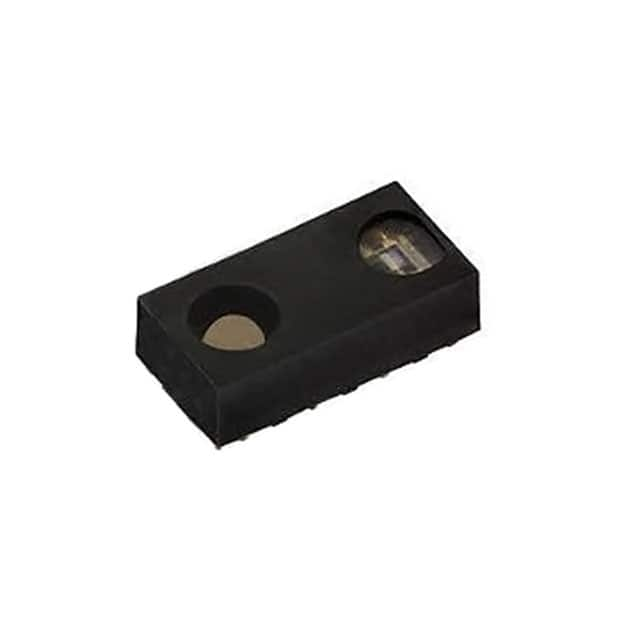Veja as especificações para detalhes do produto.

VCNL4040M3OE-H3
Introduction
The VCNL4040M3OE-H3 is a proximity and ambient light sensor designed for various applications. This entry provides an overview of the product, including its category, use, characteristics, package, specifications, pin configuration, functional features, advantages, disadvantages, working principles, application field plans, and alternative models.
Basic Information Overview
- Category: Proximity and Ambient Light Sensor
- Use: The VCNL4040M3OE-H3 is used to detect proximity and measure ambient light in electronic devices.
- Characteristics: It offers high sensitivity, low power consumption, and a compact package suitable for integration into various devices.
- Package: The sensor is available in a small surface-mount package.
- Essence: The essence of this sensor lies in its ability to provide accurate proximity and ambient light measurements in a wide range of applications.
- Packaging/Quantity: The sensor is typically supplied in reels or tubes containing multiple units.
Specifications
- Proximity Sensing Range: Up to 20 cm
- Ambient Light Sensing Range: 0.01 lux to 26850 lux
- Operating Voltage: 1.7V to 3.6V
- I2C Interface: Up to 400 kHz
- Integrated Signal Conditioning: Provides calibrated digital outputs
Detailed Pin Configuration
The VCNL4040M3OE-H3 features a standard pin configuration with pins for power supply, I2C communication, and sensor outputs. The detailed pinout is as follows: 1. VDD - Power Supply 2. GND - Ground 3. SDA - I2C Data 4. SCL - I2C Clock 5. INT - Interrupt Output 6. PS - Proximity Sensor Output 7. ALS - Ambient Light Sensor Output
Functional Features
- Proximity Sensing: The sensor utilizes an integrated infrared emitter and photodiode to accurately detect nearby objects.
- Ambient Light Sensing: It measures ambient light intensity across a wide dynamic range, enabling automatic display brightness adjustment in electronic devices.
- Integrated Signal Conditioning: The sensor provides calibrated digital outputs, simplifying integration with microcontrollers and other digital systems.
Advantages and Disadvantages
Advantages
- High sensitivity for accurate proximity detection
- Wide ambient light sensing range for versatile applications
- Low power consumption for energy-efficient operation
- Small form factor for easy integration into compact designs
Disadvantages
- Limited proximity sensing range compared to some specialized sensors
- Susceptibility to interference from external infrared sources in certain environments
Working Principles
The VCNL4040M3OE-H3 operates based on the principles of infrared reflection and ambient light absorption. The integrated emitter emits infrared light, which is reflected off nearby objects and detected by the photodiode for proximity sensing. Simultaneously, the ambient light is measured by the photodiode without the emitter being activated.
Detailed Application Field Plans
The VCNL4040M3OE-H3 is well-suited for a wide range of applications, including but not limited to: - Mobile devices for automatic screen brightness adjustment - Proximity detection in touchless interfaces for appliances and consumer electronics - Industrial automation for object detection and presence sensing - Wearable devices for gesture recognition and ambient light measurement
Detailed and Complete Alternative Models
Some alternative models to the VCNL4040M3OE-H3 include: - VCNL4040X01: A variant with extended proximity sensing range - VCNL4040M3OE-H4: A version with enhanced ambient light sensing capabilities - VCNL4040M3OE-H5: A model optimized for ultra-low power consumption
In conclusion, the VCNL4040M3OE-H3 proximity and ambient light sensor offers a balance of performance, versatility, and integration ease, making it a valuable component in various electronic devices and systems.
(Word count: 536)
Liste 10 perguntas e respostas comuns relacionadas à aplicação de VCNL4040M3OE-H3 em soluções técnicas
What is the VCNL4040M3OE-H3 sensor used for?
- The VCNL4040M3OE-H3 sensor is a proximity and ambient light sensor commonly used in various technical solutions to detect the presence of objects and measure ambient light levels.
How does the VCNL4040M3OE-H3 sensor work?
- This sensor uses infrared technology to detect the proximity of objects and measures ambient light by converting light intensity into digital data.
What are the typical applications of the VCNL4040M3OE-H3 sensor?
- Common applications include touchless switches, gesture recognition, proximity detection in mobile devices, and ambient light sensing in displays.
What is the operating voltage range of the VCNL4040M3OE-H3 sensor?
- The operating voltage range is typically between 2.5V and 3.6V.
Can the VCNL4040M3OE-H3 sensor be used in outdoor environments?
- While the sensor can be used outdoors, it may require additional protection from environmental factors such as moisture and direct sunlight.
What is the maximum range of the proximity detection for the VCNL4040M3OE-H3 sensor?
- The maximum range for proximity detection is typically around 20-30 cm, depending on the specific implementation and environmental conditions.
Is the VCNL4040M3OE-H3 sensor suitable for battery-powered devices?
- Yes, the low power consumption of the sensor makes it suitable for use in battery-powered devices.
What is the output interface of the VCNL4040M3OE-H3 sensor?
- The sensor typically provides an I2C interface for communication with microcontrollers or other devices.
Can the VCNL4040M3OE-H3 sensor be used for gesture recognition?
- Yes, the sensor's capabilities make it suitable for implementing simple gesture recognition in various technical solutions.
Are there any specific considerations for integrating the VCNL4040M3OE-H3 sensor into a design?
- It's important to consider factors such as placement, orientation, and potential interference from other light sources when integrating the sensor into a design.

